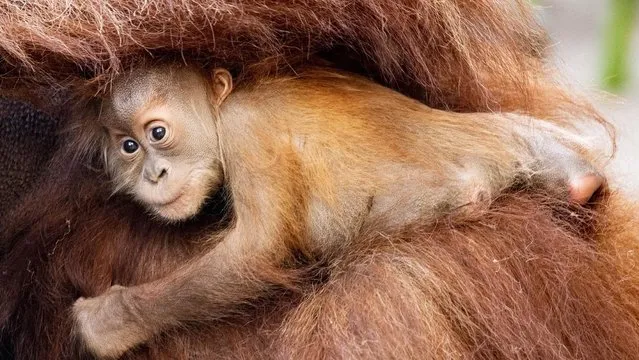
The orangutan baby “Batu” hangs in the arms of his mother “Toba” in the enclosure of the Hagenbeck Zoo in Hamburg, Germany on September 10, 2020. The Consul General of Indonesia, Wicaksono, took over the sponsorship for the ape offspring. (Photo by Axel Heimken/dpa)
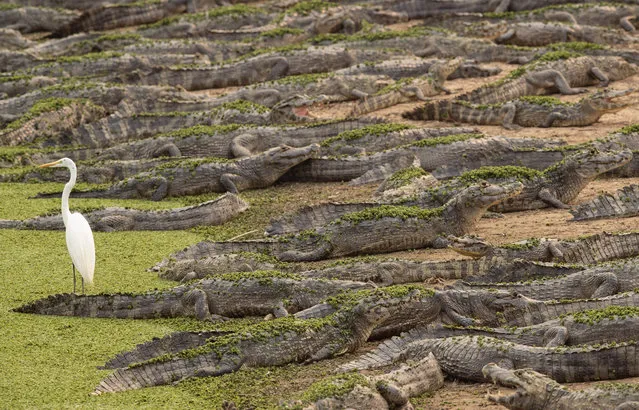
Alligators and an egret stand on the banks of the Bento Gomes river next to the Transpantaneira road at the Pantanal wetlands near Pocone, Mato Grosso state, Brazil, Monday, September 14, 2020. A vast swath of the vital wetlands is burning in Brazil, sweeping across several national parks and obscuring the sun behind dense smoke. (Photo by Andre Penner/AP Photo)
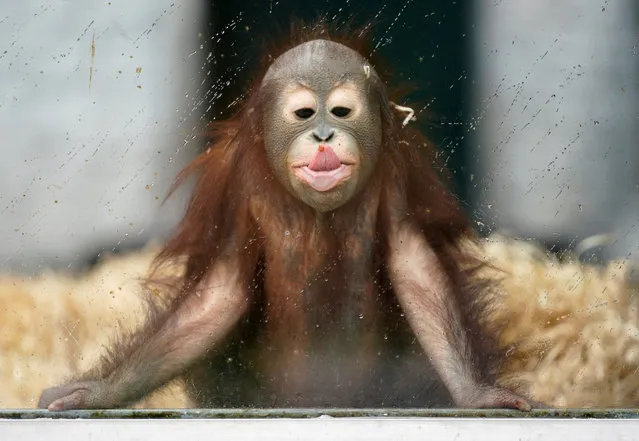
Ole, a young orangutan, plays in his enclosure at the Zoo on a rainy day in Kaliningrad, Russia on September 17, 2020. (Photo by Vitaly Nevar/Reuters)
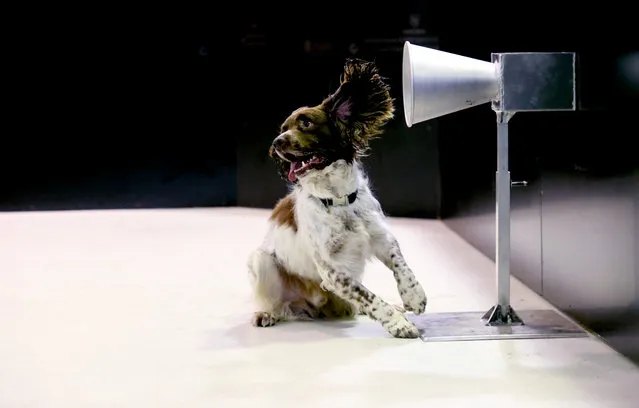
English Springer Spaniel Floki, who is 1 of 2 South Australian dogs is taking part the Covid-19 detection training at the University of Adelaide on September 18, 2020 in Adelaide, Australia. Researchers from the School of Animal and Veterinary Sciences at the University of Adelaide are working to train sniffer dogs to detect COVID-19 in people. The Adelaide study is part of an international research effort aimed at training COVID-19 detection dogs who could be used to screen people for coronavirus such as at airports, hospitals or quarantine facilities. The dogs taking part in the study at the University of Adelaide are being trained to pick the positive COVID-19 sweat sample from a line-up of samples, using positive reinforcement in the form of play with their favourite toy for each correct answer. Early results also show dogs trained in this way are able to identify infected individuals prior to the development of symptoms, or in those who are otherwise asymptomatic. (Photo by Kelly Barnes/Getty Images)
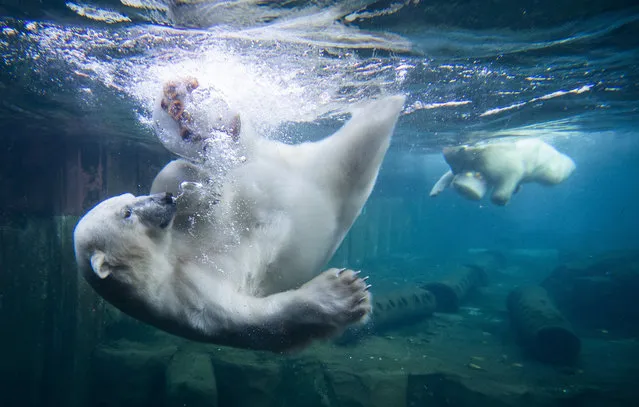
Two polar bears dive for ice cream cakes in the water basin at the Zoo in Hanover, Germany, Wednesday, September 16, 2020. (Photo by Julian Stratenschulte/dpa via AP Photo)
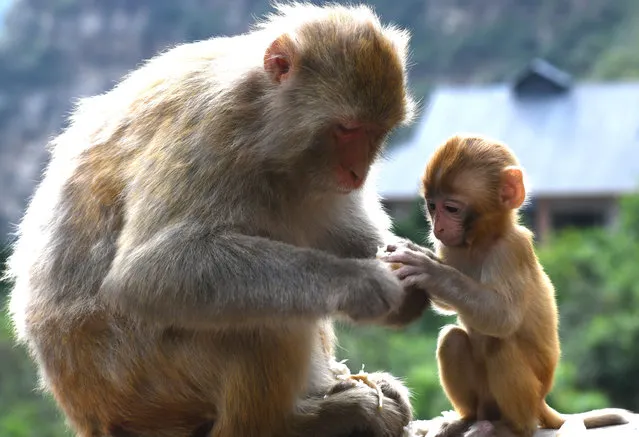
A pair of wild Taihang macaques eat fruit. Jiyuan City, Henan Province, China, September 12, 2020. (Photo by Costfoto/Barcroft Media via Getty Images)
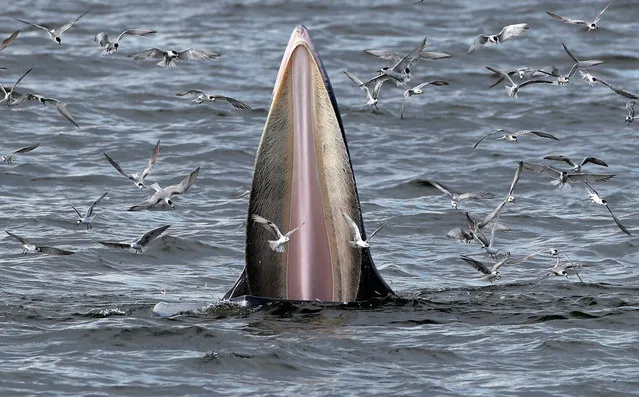
A Bryde's whale and seagulls feast on anchovies in the Gulf of Thailand, 12 September 2020 (issued 13 September 2020). Bryde's whales have been spotted more frequently after the absence of tourists and reduction of human activities due to the COVID-19 coronavirus pandemic which raises hopes of the marine ecosystem restoring after years of damage by tourism. Bryde's whale is a baleen medium sized whale with dark grey color and a white underbelly living in tropical to temperate waters. An estimated population of 40 to 60 Bryde's whales are commonly seen along the upper Gulf of Thailand coastlines between September to December. The Bryde's whale is listed in the Convention on International Trade in Endangered Species of Wild Fauna and Flora (CITES) which prohibits international trade of any parts of the animal. (Photo by Rungroj Yongrit/EPA/EFE)
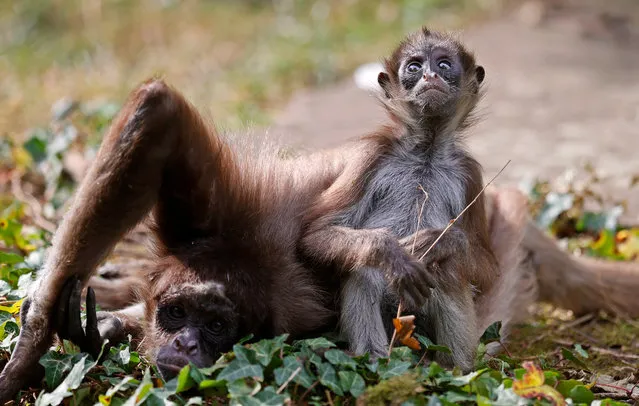
An adult and a young long-haired spider monkey (Ateles belzebuth) sit in their enclosure at zoo in Frankfurt am Main, Germany, 16 September 2020. (Photo by Ronald Wittek/EPA/EFE)
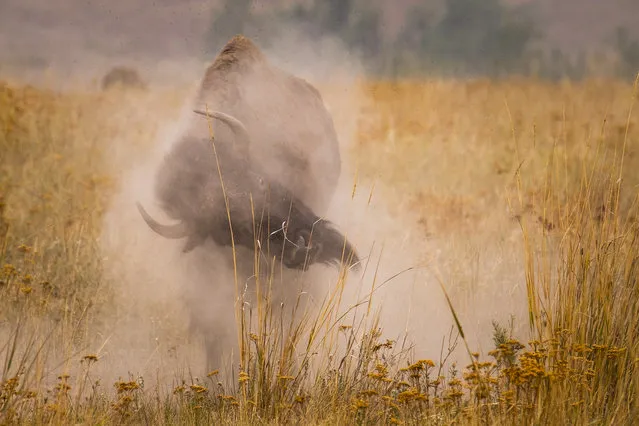
A bull bison wallows in the dirt at The Nation Bison Range which is a National Wildlife Refuge established in 1908 to provide a sanctuary for the American bison in Charlo, Montana on September 13, 2020. Around 400 bison share more than 18,000 acres with more than 200 animal species in northwest Montana on the Flathead Indian Reservation. (Photo by Kent Meireis/ZUMA Wire/Rex Features/Shutterstock)
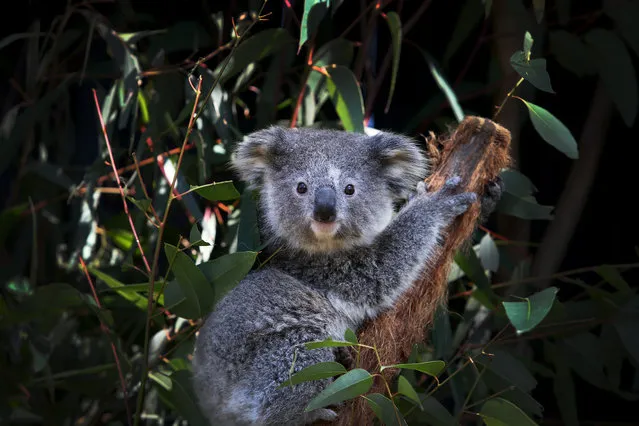
A young female koala fondly named “Ash” is seen sitting on a Eucalyptus branch following a general health check at the Australian Reptile Park on August 27, 2020 on the Central Coast in Sydney, Australia. Dean Reid, Head Mammal and Bird Keeper oversees the Australian Reptile Park's koala breeding program which currently has a record number of 38 koalas, including 9 joeys. A New South Wales parliamentary inquiry released in June 2020 has found that koalas will become extinct in the state before 2050 without urgent government intervention. Making 42 recommendations, the inquiry found that climate change is compounding the severity and impact of other threats, such as drought and bushfire, which is drastically impacting koala populations by affecting the quality of their food and habitat. The plight of the koala received global attention in the wake of Australia's devastating bushfire season which saw tens of thousands of animals killed around the country. While recent fires compounded the koala's loss of habitat, the future of the species in NSW is also threatened by continued logging, mining, land clearing, and urban development. Along with advising agencies work together to create a standard method for surveying koala populations, the inquiry also recommended setting aside protected habitat, the ruling out of further opening up of old-growth state forest for logging and the establishment of a well-resourced network of wildlife hospitals in key areas of the state staffed by suitably qualified personnel and veterinarians. The NSW Government has committed to a $44.7 million koala strategy, the largest financial commitment to protecting koalas in the state's history. (Photo by Lisa Maree Williams/Getty Images)
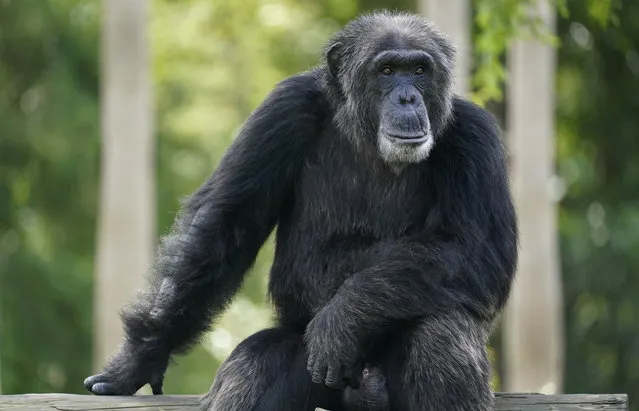
A chimpanzee looks out of his enclosure as visitors trickle into Zoo Miami, Tuesday, September 15, 2020, in Miami. The zoo reopened Tuesday as Miami-Dade and Broward counties moved to Phase 2 of reopening on Monday. (Photo by Wilfredo Lee/AP Photo)
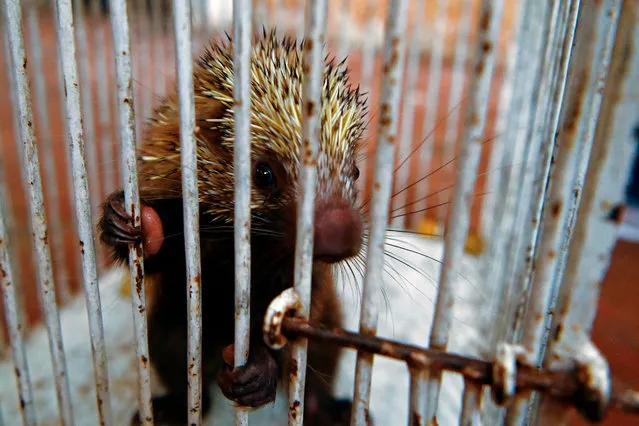
A wounded crested porcupine (Hystrix cristata) remains at the veterinary clinic of the Ministry of the Environment, waiting to be healed and then released, in San Salvador, on September 11, 2020. Many species, found by people or seized by the Environmental Police, are taken to the clinic where the team of vets is responsible for their recovery to then reintegrate them into their respective habitats. (Photo by Marvin Recinos/AFP Photo)
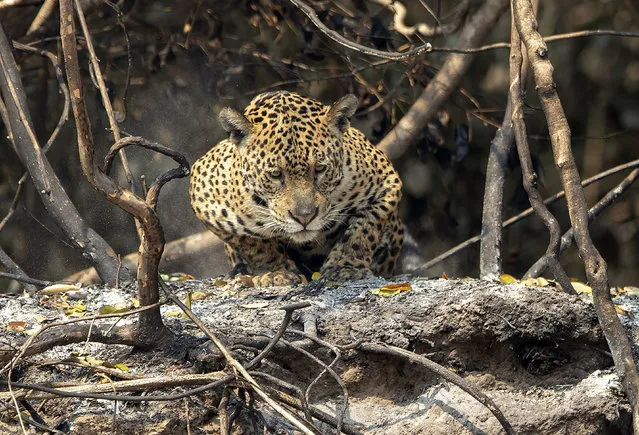
A jaguar crouches on an area recently scorched by wildfires at the Encontro das Aguas park in the Pantanal wetlands near Pocone, Mato Grosso state, Brazil, Sunday, September 13, 2020. Firefighters, troops and volunteers have been scrambling to find and rescue jaguars and other animals before they are overtaken by the flames, which have been exacerbated by the worst drought in 47 years, strong winds and temperatures exceeding 40 degrees centigrade (104 fahrenheit). (Photo by Andre Penner/AP Photo)
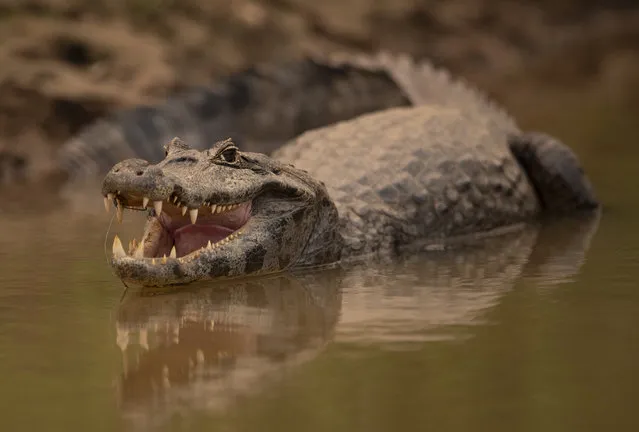
An alligator remains idling at the Encontro das Aguas park at the Pantanal wetlands near Pocone, Mato Grosso state, Brazil, Saturday, September 12, 2020. Wildfire has infiltrated the part as the number of fires at the world's biggest tropical wetlands has more than doubled in the first half of 2020, according to data released by a state institute. (Photo by Andre Penner/AP Photo)
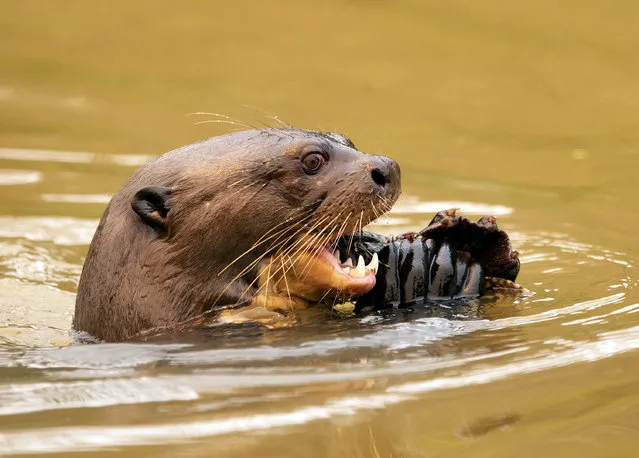
An otter eats a fish at the Encontro das Aguas park at the Pantanal wetlands near Pocone, Mato Grosso state, Brazil, Saturday, September 12, 2020. (Photo by Andre Penner/AP Photo)
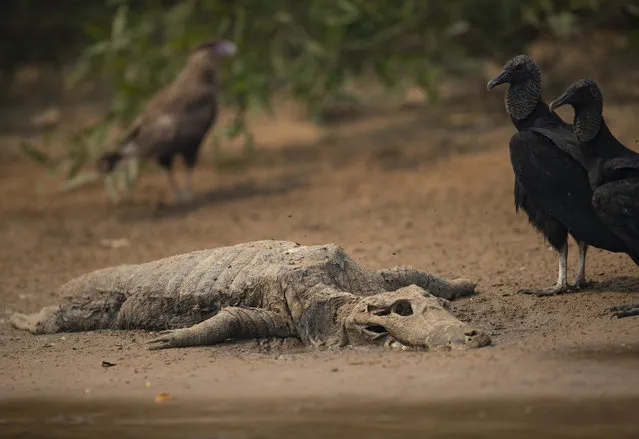
Vultures stand next to the carcass of a alligator on the banks of the Cuiaba river at the Encontro das Aguas Park in the Pantanal wetlands near Pocone, Mato Grosso state, Brazil, Saturday, September 12, 2020. (Photo by Andre Penner/AP Photo)

Pandas have fun at the China Conservation and Research Center for Giant Panda Shenshuping Base in Ngawa Tibetan and Qiang autonomous prefecture in southwest China's Sichuan province, 12 September 2020. (Photo by Rex Features/Shutterstock)
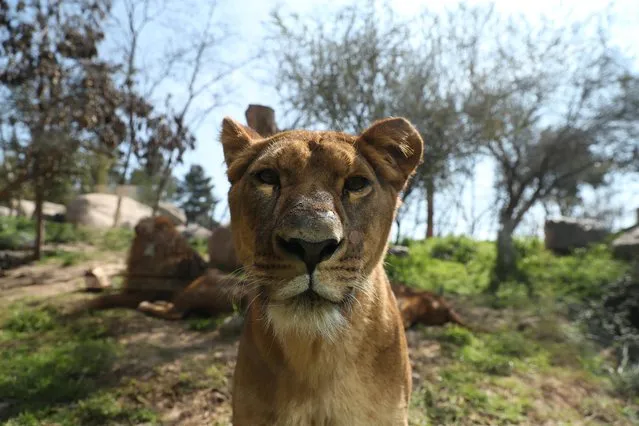
A lion is seen through a glass at the “Buin Zoo” which is looking for sponsors to funds for food, maintenance and veterinary controls for its animals due the lockdown, during the coronavirus disease (COVID-19) outbreak, in Buin, Santiago, Chile on September 9, 2020. (Photo by Ivan Alvarado/Reuters)
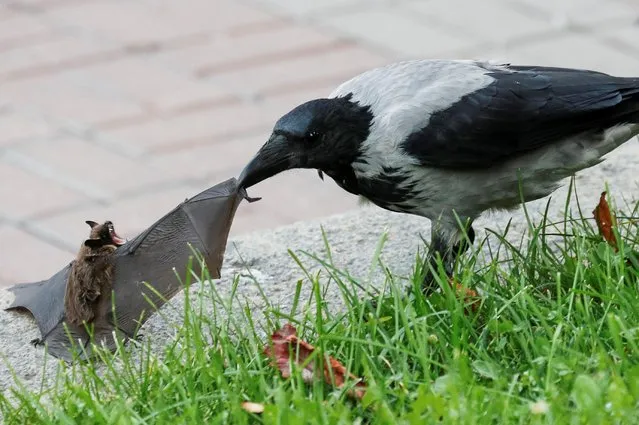
A crow attacks a bat in central Kyiv, Ukraine on September 15, 2020. (Photo by Gleb Garanich/Reuters)
20 Sep 2020 00:03:00,
post received
0 comments
